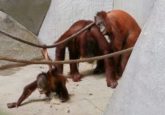Scientists discover hummingbird hybrid zone

Researchers have uncovered evidence that confirms the existence of a hybrid zone between two species of hummingbird in the USA.
It has long been theorized that Allen’s (Selaphorous sasin) and Rufous (S. rufus) hummingbirds hybridize and potentially form a hybrid zone (an area where the ranges of two species overlap and they interbreed).
Now, new evidence, published recently in The Auk: Ornithological Advances, has confirmed the existence of a previously undiscovered hybrid zone in Southern Oregon and Northern California (both USA), where the two hummingbird species blur.
The research group, led by San Diego State University’s (CA, USA) Brian Myer, analyzed behavioral and morphological data from 138 female and 183 male hummingbirds to identify the location of a hybrid zone between the two species.
Male hummingbirds perform very distinct courtship displays that vary between species. As such, researchers recorded data on male courtship behavior through sporadic inland sampling to determine the extent of the hybrid zone.
The researchers discovered that the hybrid zone spanned at least 94km along the Pacific Coast, extending north into the breeding range of S. rufus (Florence, Oregon) and south into the breeding range of S. sasin (Arcata, California).
- A global debate: can we synthesize nature to stop the loss of biodiversity?
- What lets parrots get down to monkey business?
- Prehistoric mega-herbivore decline: a case of climate not primate
Within the hybrid zone, males displayed a mix of courtship behaviors from both species, shifting from more rufous-like behaviors in the North to more Allen’s-like behaviors in the South. This confirmed that the birds were interbreeding where they mixed.
The findings of this study provide not just a deeper understanding of hummingbird species but a greater insight into interbreeding and biodiversity for all species.
“When a hybrid zone is so large, and when one of the hybridizing species has as small a range as Allen’s Hummingbird, it raises the possibility of their range shrinking even further as they’re swamped by hybrids that carry Rufous hummingbird traits and pass these genes into Allen’s Hummingbird populations,” explains Myers.
“As biodiversity continues to drop, it’s more important than ever to understand how new species form and what maintains species barriers once they’re made – is there a certain habitat or other resources that require protection? Is it more related to sexual selection? Hybrid zones are an ideal tool with which to study this.”





